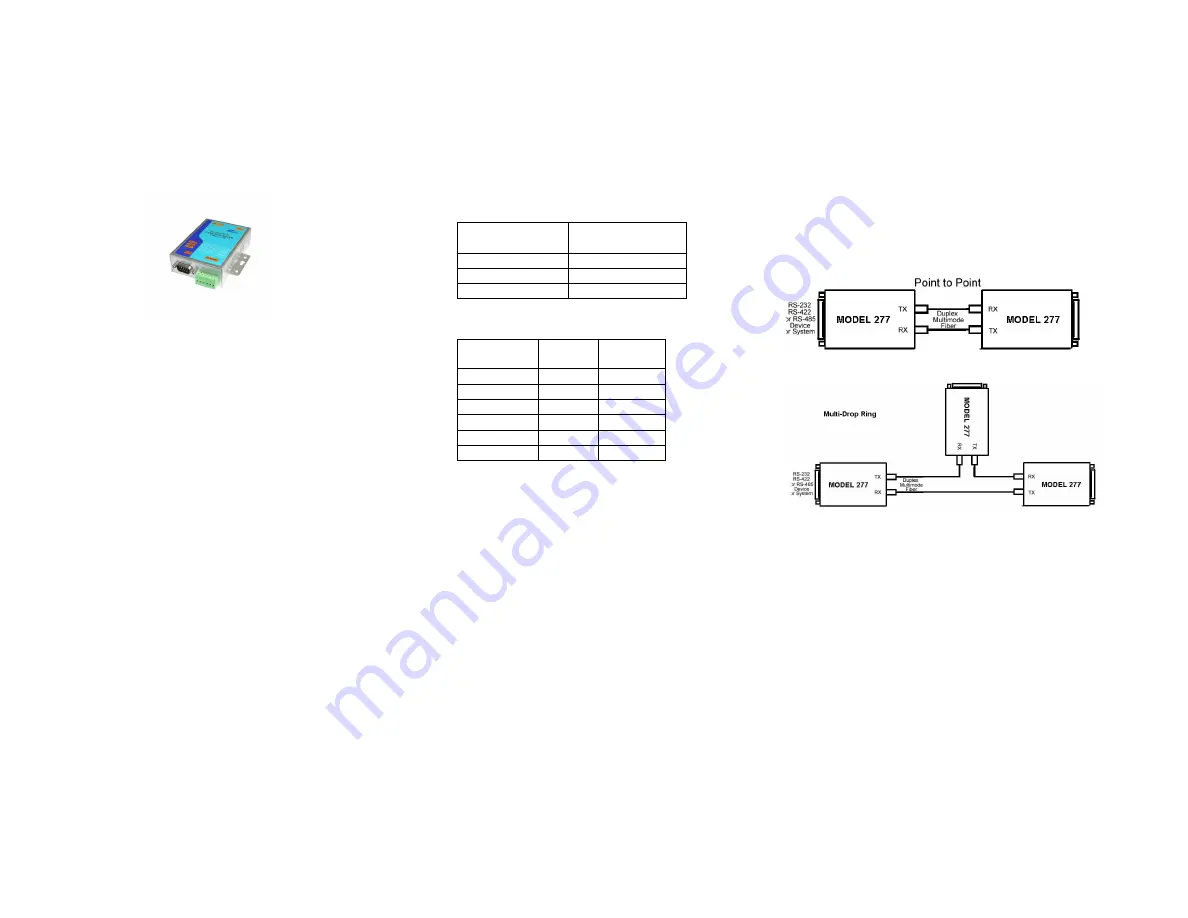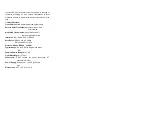
High-Speed RS-232/RS-485/RS-422
Single-Mode Fiber Optic Modem
User
’
s Manual
MODEL 277SM
1.0 Description:
The MODEL 277SM was designed to provide the most
versatile connection possible between any asynchronous
serial equipment using Fiber Optic cable. It allows any two
pieces of asynchronous serial equipment to communicate full
or half-duplex over two fibers at typical distances up to 20KM.
The converter can also be set up in "Repeater" mode to
create a multi-drop master/slave configuration, allowing one
serial device to talk to multiple slave devices around a fiber
ring.
RS-232 data signals at up to 115.2K bps and RS-422, or
RS-485 data signals at up to 115.2K bps are supported.
Different standards can be mixed and matched to allow
RS-232 devices to connect to your RS-422 or RS-485
system. This means the MODEL 277SM can replace
converters and isolators when connecting remote devices,
while providing the EMI/RFI and transient immunity of optical
fiber.
The MODEL 277SM supports both the Transmit and Receive
data lines, and provides full hardware control of the RS-422
/485 driver with automatic Send Data Control circuit.
Timeouts are auto detect between 0.10 and 2.2 ms. All serial
connections are provided on the DB-9 female connector or
6-bit terminal, while the single-mode fiber is connected via
two SC connectors. The unit is powered by 9VDC at 140 mA
max.
2.0 RS-232 Connections:
Connection of the MODEL 277SM is simple and straight
forward. The DB-9 female serial connector is used for
connecting to RS-232.The RS-232 signals are pinned as a
DTE device (input on Pin 2 and output on Pin 3)
RS-232 Connection Diagrams
DB-9 Male
(PIN)
RS-232
2
RXD
3
TXD
5
GND
3.0 RS-422 & RS-485 Connections:
RS-422/RS-485 Connection Diagrams
6-Bit
Terminal
RS-422
RS-485
PIN1
T+
485+
PIN2
T-
485-
PIN3
R+
NC
PIN4
R-
NC
PIN5
VIN
VIN
PIN6
GND
GND
4.0 Fiber Optic Connections:
The MODEL277SM uses a separate LED emitter and
photo-detector operating at 1310nm wavelength Connections
.to the emitter and detector are on ST type connectors.
Almost any multimode glass fiber size can be used including
50/125
µ
m,62.5/125
µ
m, 100/140
µ
m, and 200
µ
m. One fiber
is required for each connection between a transmitter and
receiver. In apoint-to-point configuration, two fibers are
required between the two modems, one for data in each
direction. A multi-drop ring configuration requires one fiber
between TX and RX around the loop. See Figure 3 for typical
point-to-point and multi-drop configurations.
The most important consideration in planning the fiber
optic link is the
“
power budget
”
of the fiber modem. This
value represents the amount of loss in dB that can be
present in the link between the two modems before the units
fail to perform properly. This value includes line attenuation
as well as connector loss. For the MODEL277SM the typical
connector-to-connector power budget is 13 dB. Because
62.5/125
µ
m cable typically has a line attenuation of 0.6 dB
per Km at 1310 nm, the 12 dB
power budget translates into 20 KM. This assumes no extra
connectors or splices in the link. Each extra connection
would typically add 0.5 dB of loss, reducing the possible
distance by 166 m (547 ft.). The actual loss should be
measured before assuming distances.
6.0 Multi-Drop Operation:
A multi-drop configuration is created by forming a ring of
MODEL277SM. Each transmitter is tied to the following
converter
’
s receiver, starting at a master node and continuing
around to each slave and back to the master. By setting
JP1(on PCB Mainbroad) to the
“
1-2
”
position on the slaves,
“
2-3
”
position on the Master, all data sent from the master or
preceding slaves is echoed back out the fiber transmitter to
therest of the slaves and eventually back to the master
node.Because all data is echoed back, there are special
considerations when constructing a multi-drop system. The
master will see it
’
s own transmitted data. This means that the
master device must be full-duplex (RS-232, RS-422, or




















